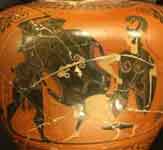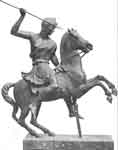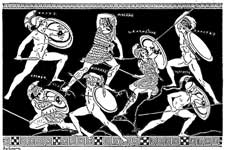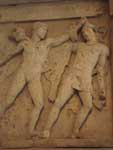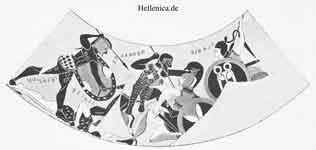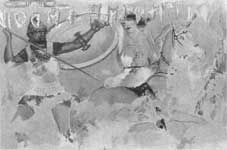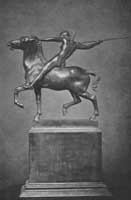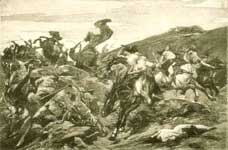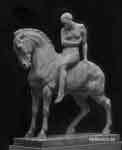Their marriage-law (Amazons) lays it down that no girl shall wed till she has killed a man in battle. Sometimes it happens that a woman dies unmarried at an advanced age, having never been able in her whole lifetime to fulfil the condition. Herodotus, Histories
In Greek mythology, the Amazons (Αμαζόνες) were either an ancient legendary nation of female warriors or a contemporary land of women at the outer edges of the world. The legends appear to have a nugget of factual basis in warrior women among the Scythians, but classical Greeks never ceased to be astounded at such unheard-of role-reversals. In early modern usage, the word was often used to refer to strong and independent women, in contrast to conventional stereotypes of women as weak and passive (see "damsel in distress"), but now "amazon" in such contexts has self-ironic overtones. (compare "Valkyrie".)
Etymology
The name Ἀμαζὼν is probably derived from an Iranian ethnonym, *ha-mazan-, originally meaning "warriors". A connected word is probably the Hesychius gloss ἁμαζακάραν· πολεμεῖν ("to make war", containing the Indo-Iranian root kar- "make" also in kar-ma).
The Greek variant of the name was connected by popular etymology to privative a + mafos, "without breast", connected with an aetiological tradition that Amazons had their right breast cut off or burnt out, in order that they might be able to use the bow more freely; there is no indication of this practice in works of art, in which the Amazons are always represented with both breasts, although the right is frequently covered. Other suggested derivations were: a- (intensive) + mafos, breast, "full-breasted"; a (privative) and masso, touch, "not touching men"; maza, a Circassian word said to signify "moon", has suggested their connection with the worship of a moon-goddess, perhaps the Asiatic representative of Artemis.
Amazons of Greek mythology
Amazons were said to have lived in Pontus near the shore of the Euxine Sea, where they formed an independent kingdom under the government of a queen, often named Hippolyta ("she lets her horses loose"). According to Herodotus (Historiesiv. 110–117) the Amazon capital was Themiscyra on the banks of the river Thermodon. From this centre they made numerous warlike excursions — to Scythia, Thrace, the coasts of Asia Minor and the islands of the Aegean Sea, even penetrating to Arabia, Syria and Egypt. They were supposed to have founded many towns, amongst them Smyrna, Ephesus, Sinope, Paphos. According to another account, they originally came to the Thermodon from the Palus Maeotis ("Lake Maeotis", the Sea of Azov).
No men were permitted to reside in Amazon country; but once a year, in order to prevent their race from dying out, they visited the Gargareans, a neighbouring tribe. The male children who were the result of these visits were either put to death or sent back to their fathers; the females were kept and brought up by their mothers, and trained in agricultural pursuits, hunting, and the art of war (Strabo xi. p. 503).
In the Iliad, the Amazons were referred to as Antianeira ("those who fight like men"). Herodotus called them Androktones ("killers of men").
The Amazons appear in connection with several Greek legends. They invaded Lycia, but were defeated by Bellerophon, who was sent out against them by Iobates, the king of that country, in the hope that he might meet his death at their hands (Iliad, vi. 186). According to Diodorus, Queen Myrine led them to victory against the Atlanteans, Libya and much of Gorgon.
They attacked the Phrygians, who were assisted by Priam, then a young man (Iliad, iii. 189). Although in his later years, towards the end of the Trojan War, his old opponents took his side again against the Greeks under their queen Penthesilea, who was slain by Achilles (Quint. Smyr. i.; Justin ii. 4; Virgil, Aen. i. 490).
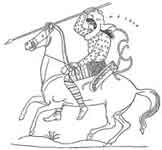

Antiope Amazon, Hypsis, Munich, Antikensammlungen, 2423
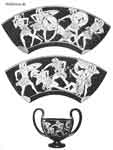
Heracles and Telamon? against the Amazons, Douris, Brussels, Musees Royaux, A718
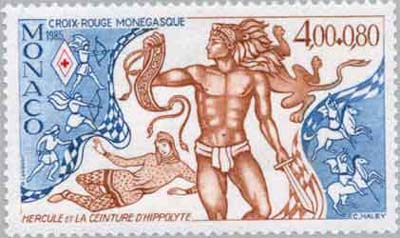
One of the tasks imposed upon Heracles by Eurystheus was to obtain possession of the girdle of the Amazonian queen Hippolyte (Apollodorus ii. 5). He was accompanied by his friend Theseus, who carried off the princess Antiope, sister of Hippolyte, an incident which led to a retaliatory invasion of Attica, in which Antiope perished fighting by the side of Theseus. In some versions, however, Theseus marries Hippolyte and in others, he marries Antiope and she does not die. The battle between the Athenians and Amazonians is often commemorated in an entire genre of art, amazonomachy, marble carvings such as from the Parthenon.

Battle of the Amazons, Rubens. The Amazons against Theseus.
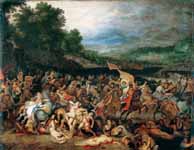
The Battle of the Amazons, Rubens
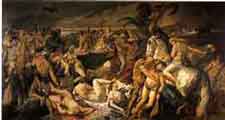
The Amazons are also said to have undertaken an expedition against the island of Leuke, at the mouth of the Danube, where the ashes of Achilles had been deposited by Thetis. The ghost of the dead hero appeared and so terrified the horses, that they threw and trampled upon the invaders, who were forced to retire.
They are heard of in the time of Alexander the Great, when their queen Thalestris visited him and became a mother by him, and Pompey is said to have found them in the army of Mithradates.
Scythian origins
Before modern archaeology uncovered some of the Scythian burials of warrior-maidens entombed under kurgans in the Altai region of Siberia, giving concrete form at last to the Greek tales of mounted Amazons, the origin of the story of the Amazons has been the subject of speculation among classics scholars. In the 1911 Encyclopaedia Britannica speculation ranged along the following lines.
While some regard the Amazons as a purely mythical people, others assume an historical foundation for them. The deities worshipped by them were Ares (who is consistently assigned to them as a god of war, and as a god of Thracian and generally northern origin) and Artemis, not the usual Greek goddess of that name, but an Asiatic deity in some respects her equivalent. It is conjectured that the Amazons were originally the temple-servants and priestesses (hierodulae) of this goddess; and that the removal of the breast corresponded with the self-mutilation of the god Attis and the galli, Roman priests of Cybele. Another theory is that, as the knowledge of geography extended, travellers brought back reports of tribes ruled entirely by women, who carried out the duties which elsewhere were regarded as peculiar to man, in whom alone the rights of nobility and inheritance were vested, and who had the supreme control of affairs. Hence arose the belief in the Amazons as a nation of female warriors, organized and governed entirely by women. According to J. Vurtheim (De Ajacis origine, 1907), the Amazons were of Greek origin: "all the Amazons were Dianas, as Diana herself was an Amazon". It has been suggested that the fact of the conquest of the Amazons being assigned to the two famous heroes of Greek mythology, Heracles and Theseus – who in the tasks assigned to them were generally opposed to monsters and beings impossible in themselves, but possible as illustrations of permanent danger and damage – shows that they were mythical illustrations of the dangers which beset the Greeks on the coasts of Asia Minor; rather perhaps, it may be intended to represent the conflict between the Greek culture of the colonies on the Black Sea and the barbarism of the native inhabitants.
Herodotus reported that the Sarmatians/Sauromatians were descendants of Amazons and Scythians. Their Scythian/Saka/Cimmerian/Gomerian/Celtic origins are further proved by their origins from Thermodon's Scythians who invaded there coming from around the Sea of Azov and their use of the bow-and-arrow as their primary weapon as well as fighting on horseback.
Medieval and Renaissance authors credit the Amazons with the invention of the battle-axe. This is probably related to the Sagaris, an axe-like weapon associated with both Amazons and Scythian tribes by Greek authors (see also Aleksandrovo kurgan). Paulus Hector Mair expresses astonishment that such a "manly weapon" should have been invented by a "tribe of women", but he accepts the attribution out of respect for his authority, Johannes Aventinus.
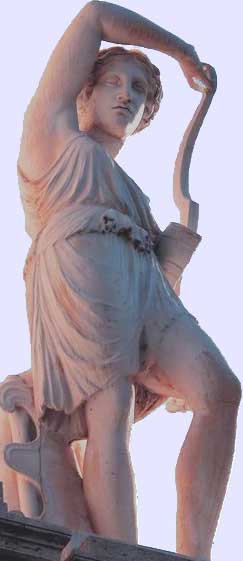
(Source)
Amazons in Greek art


The wounded Amazon, (right version in the Vatican)
In works of art, combats between Amazons and Greeks are placed on the same level as and often associated with combats of Greeks and centaurs. The belief in their existence, however, having been once accepted and introduced into the national poetry and art, it became necessary to surround them as far as possible with the appearance of not unnatural beings. Their occupation was hunting and war; their arms the bow, spear, axe, a half shield, nearly in the shape of a crescent, called pelta, and in early art a helmet, the model before the Greek mind having apparently been the goddess Athena. In later art they approach the model of Artemis, wearing a thin dress, girt high for speed; while on the later painted vases their dress is often peculiarly Persian – that is, close-fitting trousers and a high cap called the kidaris. They were usually on horseback but sometimes on foot. The battle between Theseus and the Amazons is a favourite subject on the friezes of temples (e.g. the reliefs from the frieze of the temple of Apollo at Bassae, now in the British Museum), vases and sarcophagus reliefs; at Athens it was represented on the shield of the statue of Athena Parthenos, on wall-paintings in the Theseum and in the Poikile Stoa. Many of the sculptors of antiquity, including Pheidias, Polyclitus, Cresilas and Phradmon, executed statues of Amazons; and there are many existing reproductions of these.
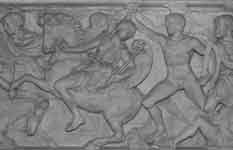
Amazonomachy (fight between Greeks and Amazons), relief of a sarcophagus (ca. 180 BC), found in Salonica, 1836.
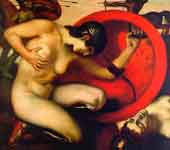
Wounded Amazon, Franz von Stuck |
Amazon-like cultures in history
Armed women have often acted as royal bodyguards throughout history. Chandragupta Maurya (322–298 BC), the first emperor to develop a centralized state in India, had a personal guard composed of giant Greek women. Female royal guards re-appear 2000 years later in the history of India as guards for the Nizams of Deccan and Hyderabad. And on the island of Sri Lanka, the Kandy royal family had a royal guard of female archers. In Europe, Celtic and Germanic tribes often had women fighting with their husbands. Tacitus tells us that Boadicea had more women than men in her army.
In Scandinavia, women who did not yet have the responsibility for raising a family could take up arms and live like warriors. They were called shieldmaidens and many of them figure in Norse mythology. One of the most famous shieldmaidens was Hervor and she figures in the cycle of the magic sword Tyrfing. The Danish chronicler Saxo Grammaticus relates that when the Swedish king Sigurd Ring and the Danish king Harald Wartooth met at the Battle of Bråvalla, 300 shieldmaidens fought on the Danish side led by Visna. Saxo relates that the shieldmaidens fought with small shields and long swords.
A legend which may be based on the Greek Amazons appears in the history of Bohemia. As the story goes, a large band of women, lead by a certain Vlasta, carried on war against the duke of Bohemia, and enslaved or put to death all men who fell into their hands; eventually, they were mercilessly defeated by the duke. In the 16th century the Spanish explorer Orellana asserted that he had come into conflict with fighting women in South America on the river Maranon, which was named after them the Amazon or river of the Amazons, although others derive its name from the Indian amassona (boat-destroyer), applied to the tidal phenomenon known as the "bore".

Dahomey Amazons holding muskets. The horns are indicators of rank
The Dahomey Amazons were a 6000 strong military unit of Dahomey (now Benin) in West Africa who were active from the 16th to the late 19th century. There were largely successful in their battles with neighboring kingdoms, and were finally defeated by the French. Libya has a long history of Amazon women, which probably pre-dates the Greek Amazons. Even today, Gadaffi is guarded by female soldiers. Other African ethnic groups who used fighting women were the Igbo and Fulani, who integrated the women into their armies.
In the kingdom of Siam in the 19th century, the king had a personal battalion of 400 spear-wielding women. They were chosen from the most beautiful women of the country, and were said to be excellent spear-throwers, though they were regarded as too valuable to be sent to war. Other peoples who had female fighters include the Arabs, Australian Aborigines, Berbers, China, Kurds, Filipinos, Maori, Micronesians, Papua New Guinea and Rajputs.
Around 400 women took part as soldiers in the American Civil War. For notable cases of women who have become soldiers, reference may be made to Mary Anne Talbot and Hannah Snell.

Modern depiction of Amazons
It has been noted that until the 20th century, Amazons were typically depicted in literature as an alien adversary that threatened the masculinity of heroes. As such, the typical goal of the heroes has been to defeat and humiliate them as a way of reasserting male superiority.
In the 20th century, Amazons were depicted with increasing sympathy. Today, the typical depiction of the characters is as an isolated community of powerful and beautiful warriors whom the male heroes are challenged to earn their respect to become valuable allies.

Amazonis Planitia, a region on the planet Mars named after the Amazons (the position relative to Mount Olympus is shown).
Links
Amazon on a Horse (390-380 BC) from the Epidaurus Asklepios Temple (Austrian Site)
Secrets of the Dead: Amazon Warrior Women (PBS) (http://www.pbs.org/wnet/secrets/case_amazon/index.html) - includes information on genetic and archaeological study of recent finds of skeletons in tombs
Amazon Nation (http://www.moonspeaker.ca/amazonsframe.html) The Amazons existed. But, their history has been long lost, or else so corrupted by later peoples who would rather we forgot them they are barely recognizable. This is a version of a book in progress, so you may notice differences if you were to compare it to a printed version.
[1] (http://www.stevequayle.com/Giants/W.Europe/W.Europe4.html) The Amazons existed. They were originally warrior women of Scythians. Greeks later added them to their mythology even sometimes deitifying some of them.
The Amazon Connection (http://folk.uio.no/thomas/lists/amazon-connection.html) - A guide to online resources about Amazons, aiming to cover the entire spectrum of meaning that has been attributed to the term Amazon.
Amazons International (http://folk.uio.no/thomas/lists/amazons.html) - A newsletter dedicated to the image of the Amazon or female hero in fiction and in fact, in art and literature, in the physiques and feats of female athletes, and in gender-related and sexual orientations.
Amazon, Sculpture, Berlin Germany
References
A. D. Mordtmann, Die Amazonen (1862)
W. Stricker, Die A. in Sage und Geschichte (1868)
A. Klugmann, Die A. in der attischen Literatur und Kunst (1875)
H. L. Krause, Die Amazonensage (1893)
F. G. Bergmann, Les Amazones dans l'histoire et dans la fable (1853)
P. Lacour, Les Amazones (1901)
articles in Pauly-Wissowa's Realencyclopadie, and Roscher's Lexikon der Mythologie
Grote, Hist. of Greece, pt. i. ch. 11.
J. A. Salmonson, The Encyclopedia of Amazons (1991), ISBN 0385423667
|
Amazons Amazons of Andromache Amazons of Antianara Amazons of Hipp Amazons of Hippolyte Amazons of Lysippe Amazons of Marpesia Amazons of Oreithyia (daughter of Marpesia) and Antiope, Attic War Amazons Amazons of Penthesilea, Quintus Smyrnaeus's Posthomerica (book i) Amazons of Thalestris Amazons of Valasca |
See also : Greek Mythology. Paintings, Drawings
Retrieved from "http://en.wikipedia.org/"
All text is available under the terms of the GNU Free Documentation License
| Ancient Greece
Science, Technology , Medicine , Warfare, , Biographies , Life , Cities/Places/Maps , Arts , Literature , Philosophy ,Olympics, Mythology , History , Images Medieval Greece / Byzantine Empire Science, Technology, Arts, , Warfare , Literature, Biographies, Icons, History Modern Greece Cities, Islands, Regions, Fauna/Flora ,Biographies , History , Warfare, Science/Technology, Literature, Music , Arts , Film/Actors , Sport , Fashion --- |


